Home / All Recipes / Indonesian / Rendang Sapi Padang - Padang Style Beef Rendang
Rendang Sapi Padang - Padang Style Beef Rendang
Recreate the world's most delicious food (beef rendang) in your kitchen. Now you don't have to visit Indonesia or Malaysia to sample authentic rendang.
Rendang sapi (beef rendang) is probably the most well known Padang dish, and surprisingly easy to make at home, since most of the time you just need to let it simmer away on a stove.
The key to successful rendang is not to skimp on the herbs and spices, and be prepared for a long stewing process resulting in a flavorful and tender melt in your mouth pieces of beef.
In short, good stuff which I guarantee a bite of this will have you nodding in agreement with all the people who have voted rendang to be the world’s most delicious food.
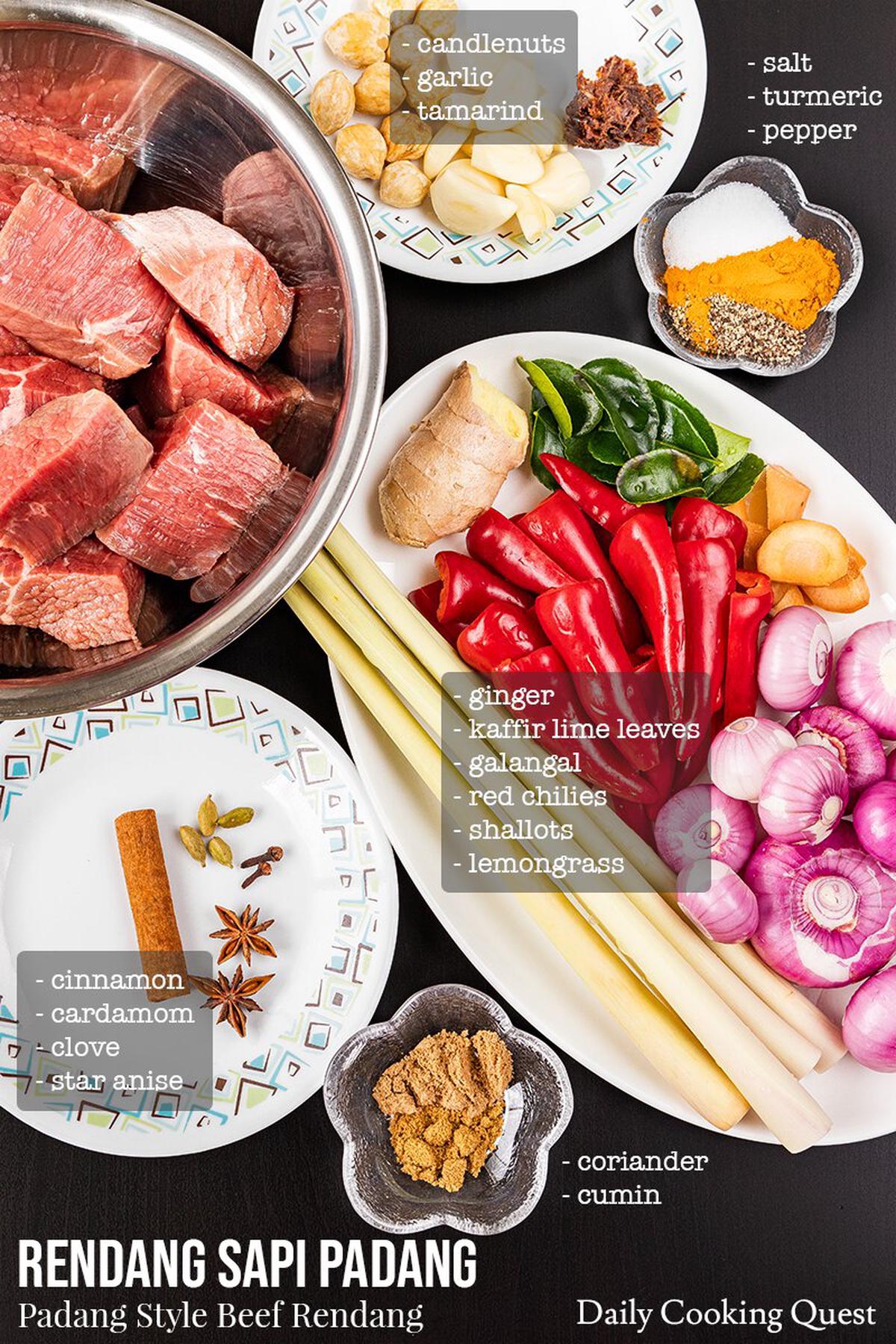
The herbs and spices you need to prepare for a rendang dish
After so many years of tweaking and tinkering my beef rendang recipe, for the moment, I am highly satisfied with this version to recreate my beloved beef rendang, Padang style. But be warned, the long list of ingredients is definitely not for the faint of heart.
The essentials
For me, the following is the minimum amount of herbs and spices that you definitely must incorporate in your beef rendang:
- coconut milk
- kaffir lime leaves
- lemongrass
- ginger
- galangal
- asam kandis/asam gelugur/black kokum/tamarind
- shallots
- garlic
- red chilies
- turmeric
- candlenuts
Tamarind is the easiest to procure in the United States, followed with black kokum, but in Indonesia, we usually use asam kandis, or asam gelugur to prepare rendang dishes.
The extras, but oh so worth it
And here are the list of herbs and spices that may be safely omitted, though if you are willing to go the extra mile, you won’t regret adding some, if not all, of the following:
- cinnamon
- cardamom
- star anise
- cloves
- coriander
- cumin
- Indonesian bay leaves (Indonesian: daun salam)
- coconut water, instead of water
- turmeric leaves
From my own experience, other than turmeric leaves, you should be able to buy the rest of the ingredients in the United States. If you have green thumbs, you can buy some fresh turmeric roots and grow turmeric plants and harvest the fresh leaves to use for all your rendang dishes.
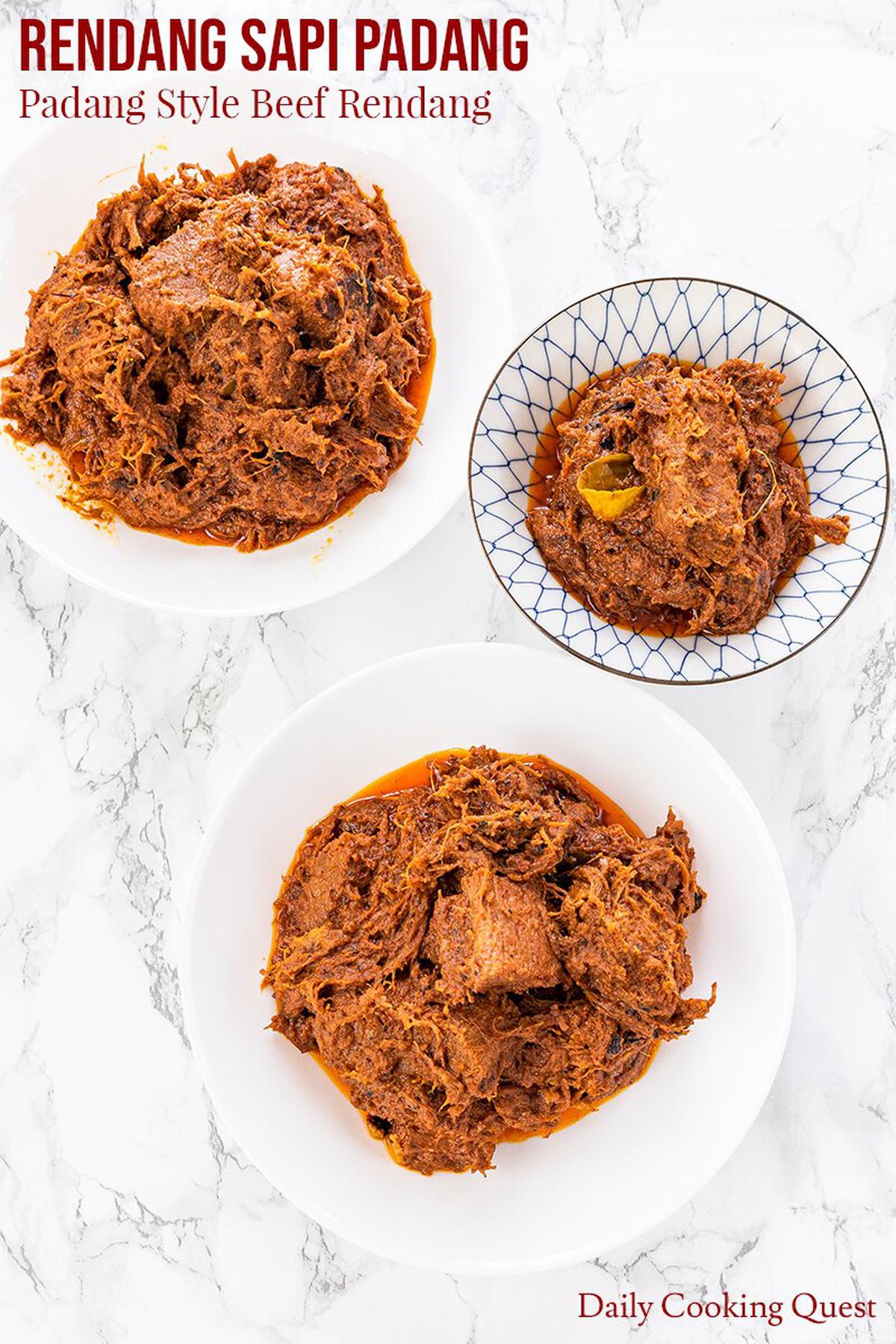
Which beef cut is suitable for beef rendang?
Rendang is a dish with long hours of slowly simmering away in a pot (most Indonesians use a wok actually), until all the liquid is reduced into a glaze! As such, you want to stick with beef cuts that are highly suitable for stew or braising. My favorites include:
- beef chuck
- beef shank, also known as shin
- beef bottom round/rump roast (in the US), or silverside (outside of the US)
- beef brisket
The first three are more commonly used to cook beef rendang, but you can also use brisket too. If your grocery only carries beef cubes that are labeled as beef stew, you can use that too, just make sure they are around 2-inch cubes.
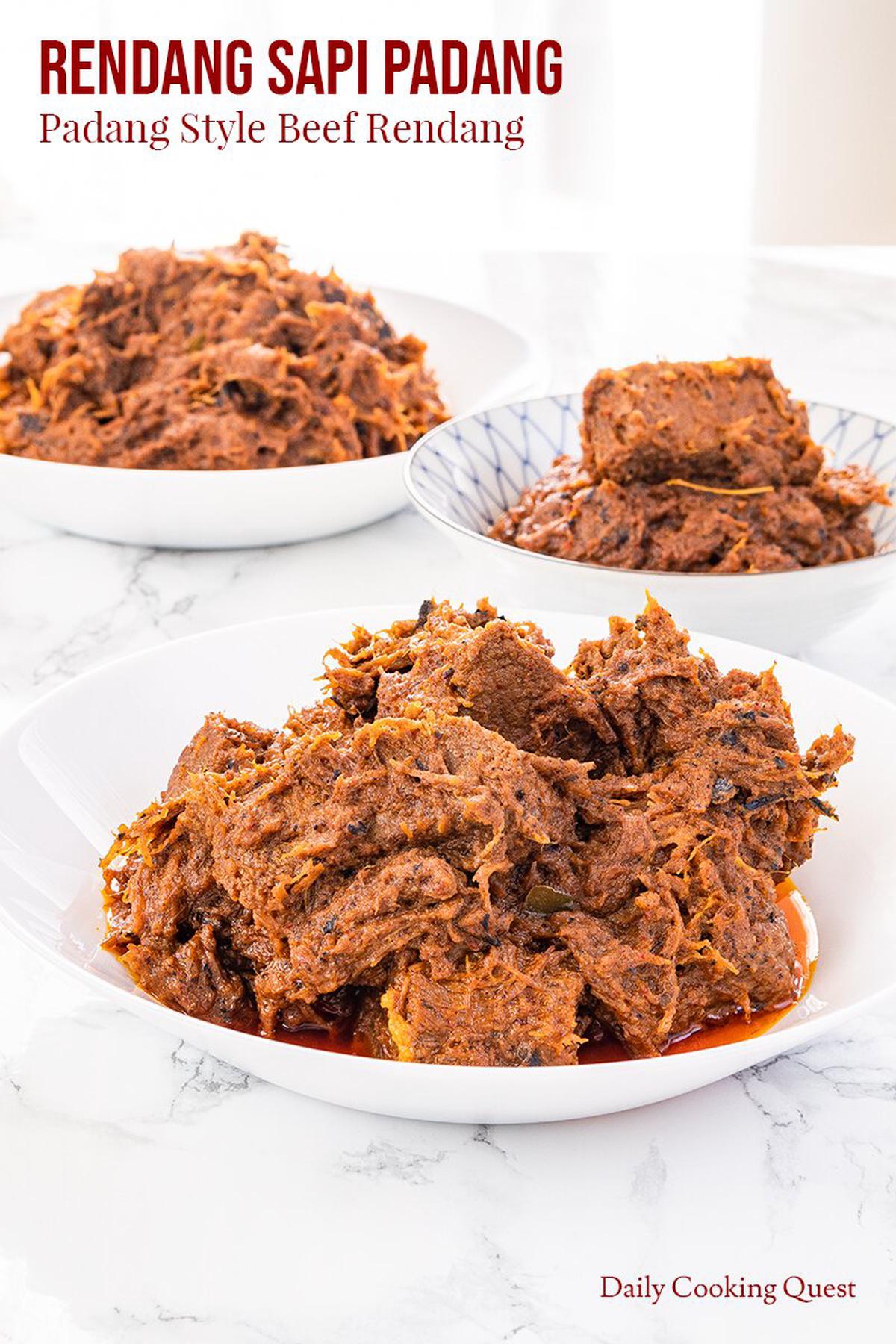
What is the difference between Padang style beef rendang to others?
The biggest difference between Padang style beef rendang compared to other beef rendang is the lack of ambu-ambu, or kerisik.
What is ambu-ambu/kerisik?
Ambu-ambu, or kerisik as they are known in Malaysian, is a buttery concoction made from toasted grated coconut. It’s actually very easy to make, simply dry fry freshly grated coconut until toasty and golden brown, then ground this until the toasted grated coconut becomes an oily paste.
So, can I use ambu-ambu/kerisik for my rendang if I wish to?
If you are used to beef rendang that includes this ingredient, feel free to add some kerisik (about 4 tablespoon) near the end of your cooking, typically right before it’s done.
Rendang Sapi Padang - Padang Style Beef Rendang
Ingredients
- 4 tablespoon oil, preferably coconut oil
- 5 kaffir lime leaves (Indonesian: daun jeruk), remove the ribs
- 4 lemongrass (Indonesian: sereh), bruised and knotted
- 5 Indonesian bay leaves (Indonesian: daun salam) (*)
- 2 fresh turmeric leaves, knotted (*)
- 1 cinnamon stick (Indonesian: kayu manis) (*)
- 4 cardamom pods (Indonesian: kalupaga), crushed (*)
- 2 cloves (Indonesian: cengkeh) (*)
- 2 star anise (Indonesian: pekak/bunga lawang) (*)
- 1 kilogram (~ 2.2 lb.) beef shank or chuck (Indonesian: daging sengkel atau sandung lamur), cut into 2 inch by 2 inch cubes
- 800 ml coconut milk (usually 2 cans of coconut milk)
- 1200 ml water/coconut water
- 2 asam kandis/2 asam gelugur/2 black kokum/10 gram (~ 2 teaspoon) tamarind
- Grind the following into spice paste
- 250 gram (9 oz.) shallots (~ 20 Asian shallots, or ~ 6 French shallots) (Indonesian: bawang merah)
- 10 cloves garlic (Indonesian: bawang putih)
- 100 gram (3.5 oz.) red chilies (Indonesian: cabe merah keriting)
- 10 candlenuts (Indonesian: kemiri)
- 2 inches ginger (Indonesian: jahe)
- 2 inch galangal (Indonesian: lengkuas)
- 2 inches turmeric (~ 1 teaspoon turmeric powder) (Indonesian: kunyit)
- 1 teaspoon coriander seeds (~ 3/4 teaspoon coriander powder) (*)
- 1 teaspoon cumin seeds (~ 3/4 teaspoon cumin powder) (*)
- 1 tablespoon pepper
- 1 tablespoon salt
Instructions
- Heat oil in a wok/large pot over a medium-high heat and fry the spice paste, kaffir lime leaves, lemongrass, Indonesian bay leaves, cinnamon stick, crushed cardamom pods, cloves, and star anise until fragrant. About 3-5 minutes.
- Add beef cubes, stir until no longer pink.
- Add coconut milk and water/coconut water, along with asam kandis/asam gelugur/black kokum/tamarind. Stir to mix well, and bring to a boil.
- Reduce heat a bit (still above simmering point) and left the wok/pot uncovered. Cook until the liquid is reduced and thickened.
- Once the liquid has thickened, reduce the heat and simmer until all the liquid is almost gone and the beef looks a bit dark. Also, you should see oil separates from the sauce.
- Remove from heat and serve hot or at room temperature. Beef rendang actually improves with storage time, so if you are patient, try serving this the next day.
Notes
- (*) Ingredients marked with (*) are optional, but highly recommended. Try to include some of these ingredients for an even more delicious rendang.


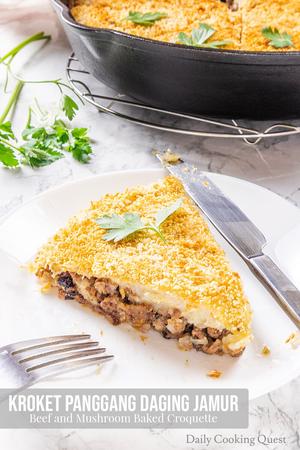
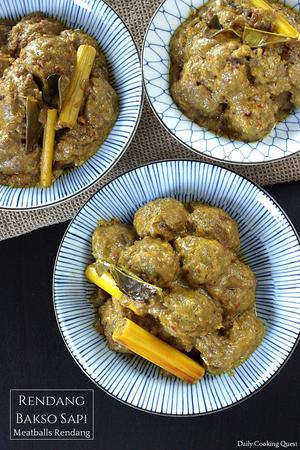
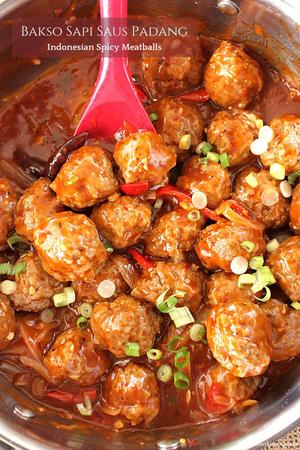
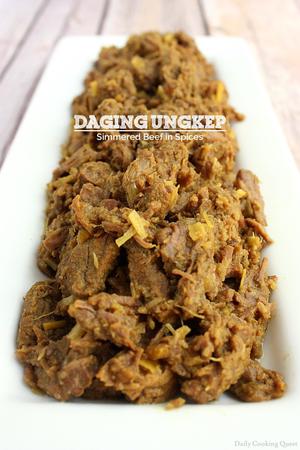
Comments
I'm so excited to make this for my family. I grew up in Jakarta but never learned how to make this dish! Thank you!
Will sure trying this out! Looks perfect!
Mouth watering...love it! Thanks for the recipe..
With the beef rending recipe when do you add the spice paste?
Hi Geoff, it's at the first step. Hope this clarifies the recipe.
Hi Anita. I am hoping that you can educate me about rendang. What's the difference between Padang rendang and other beef rendang? I notice this recipe doesn't require browning the meat. From what I'm reading, this dish is like a stew that cooked down. Pretty much cook water and coconut milk with the spice and add the meat. Am I missing any step? Thanks for clarifying. Thank you. Happy New Year
Hi Gwen, as far as I know, Malaysian rendang always use kerisik. So if you are used to that version, simply add about 4 tablespoon of kerisik at the end of the cooking time.
Wondering what “thick coconut milk” refers to. Coconut cream or regular full fat coconut milk. Please clarify for us westerners!!
Hi Lauren, sorry if the recipe is unclear. I have modified the recipe to use the widely available canned coconut milk. :)
Excellent dish. Done Indonesian cooking for over 40 years, but never had a proper Rendang recipe. This one's simple and exquisite.
Isn't it? Most people stop once reading through the ingredients list, but the cooking process itself is so simple. :)
So you really just put EVERYTHING together at once (paste, water, beef, everything) and bring it to boil and then step 2-4?
Hi Phil. Yes, I just put everything in the pot (spice paste, water, beef, everything), and slowly simmer until almost dry. UPDATE: I have updated the recipe with a more detailed step-by-step, so now I don't just dump everything in the pot and let it simmer away, though you can still do that if you wish.
hi Anita, thanks for this recipe! I'm hoping to do this with a pressure cooker, any advise on modification of the liquids?
Hi Therese, I don't own a pressure cooker, so I can't give you tips from my own experience. But from what I can gather through various recipes from the internet, it seems that people simply use coconut milk and skip the water when using a pressure cooker and cook for 45 minutes. If you end up experimenting, it would be awesome if you can share your experience with me.
Hi Anita, Cooking this recipe as I type. Could you just clarify what type of pepper should be used... black, white.. freshly cracked, powder?? Can't wait to taste!
Hi Benny, I usually use ground white pepper for this since that is what my Mom uses back home. But, in a pinch, regular ground black pepper will do the job. :)
I cooked this and it was very nice..will definitely make these again..I didn't use chillies as I wanted my 4 y.o daughter to eat it too.. it will be my to go recipe when ever I want to make rendang.
I'm happy you love it, Rina. I, too, only use the full amount of chilies when I'm sure everyone who's going to eat it is used to eating spicy food. :)
I've never made padang at home. It's perfect, becasue we have extra brisket in the fridge and it looks like this recipe will be perfect for it.
I LOVE rendang! Thanks for sharing such a wonderfully AUTHENTIC recipe! It's right up my alley!
I have never had this dish at home but I have had it in a restaurant and I loved it. I can't wait to make it at home for my family.
So flavorful and easy to make! Thank you!
This dish sounds really good and I think it will pair well with rice. Definitely would love to make it and introduce something new and different to my family.
Hi, at step #4, the instruction said “ Cook until the liquid is reduced and thickened.” How long does this take for this step to get the beef to become tender they they’re the tougher cut of beef? I plan to cook this tomorrow so your quick response is appreciated!
Hi YC, if you are using tougher cuts, I would suggest at least 3 hours of slow simmering. Once the beef is tender and you still have plenty of sauce, you can increase the heat to reduce the sauce at a faster pace.
This looks absolutely delicious! Such a variety of spices and flavors here. Can't wait to give it a try!
I adore your recipes for their authenticity! Yes, I traveled to Indonesia in the past, but to recreate that country's cuisine is not easy. Your site is the perfect guide. I made this beef recipe with some minimal changes, it was delicious! Thanks a lot.
Oh my, it looks AMAZING. I am ashamed to say that I have never tried beef rendang before. I've heard about it, but never tried. Thanks you for the recipe!
I love how Indonesian cuisines over generous with the seasoning. That's what Caribbean food is all about so I can already imagine how flavoursome Rendang is especially with slow cooking the beef.
I just made this.. first time. It was ridiculously amazing. I added half a table spoon of gula Jawa (coconut sugar) ... being Javanese 😋 Thank you so much for this delightful recipe. 5 stars 🌟
Hi Anita, thanks for the great recipe. I just tried it and the rendang taste good. I used 400 ml of coconut milk though and added 2 tablespoons of gula melaka. Thanks much!!!
Hi Anita, after weeks of searching I have settled on your recipe to attempt my first homemade rendang! I spent my younger years in Jakarta (age 3-15) and ate rendang several times a week from the local padang stands/restaurants and have been craving it since relocating to the States! I found a local resource for fresh turmeric leaves, lemongrass, galangal root, kaffir lime leaves..and will be ordering dried asam kandis from Europe along with dried daun salam leaves :( I know i can use Kokum as a substitue but wanted to try and source asam kandis...they said it's dried so no need to worry about mold (fingers crossed). I've seen some recipes call for grated nutmeg and palm sugar, and was wondering if you've used this? And if you do would you just add it to the liquid or would you fry with the spice mix? Do you leave the star anise/asam kandis in until the end then remove? Also, I have seen some people use organic coconut cream rather than coconut milk, or a mixture of both..any thoughts on this? Terimah kasih banyak! :)
Hi Zac, thanks for choosing my recipe to try. :) It is very seldom to see nutmeg in rendang, maybe it's a regional variation or perhaps certain families just prefer the taste? Palm sugar, on the other hand, is very common in rendang prepared in a Javanese restaurant or a Javanese household since this is de facto sugar in Javanese dishes. If I were to add these, I will add the nutmeg to the spice paste, and the palm sugar at step 3.
For asam kandis and star anise, yes I will leave them while cooking and remove at the end.
Traditional rendang recipes usually say something like obtain 1.5 L santan (coconut milk) from 3 coconuts, so it leaves room for interpretation when translating this to canned coconut cream/milk. You can certainly use the same amount of coconut cream instead of coconut milk for a richer indulgence.
Thanks for this recipe! I’m trying it out next week for my friends, some of which having yet to try indo food! I’m wondering about the cloves measurement? I have whole cloves, but I’m not sure what the number 2 is referring to.
Hi Anna, I use 2 whole intact cloves, not the powder/ground version :)
The best!!
HI Anita, Can I replace beef with Chicken or will the spices be too strong for chicken? what's the difference the Chicken Rendang recipe and the Beef Rendang?
Hi Bee, you can use this recipe and replace the beef with chicken if you want to. The main difference is that I try to be as faithful to the authentic Padang recipe for this one, while the one for chicken rendang is something that has evolved from my Mom's tinkering. ;)
Hi mba Anita. Boleh tanya kalau saya mau pake slow cooker, harus masak berapa lama supaya daging nya ga terlalu empuk? Terima kasih mba Anita
Halo Dewi, coba dimasak dengan slow cooker dengan "low" selama 6 jam saja. Setelah itu kalau rendang masih terlalu berkuah, sebaiknya dipindahkan ke wajan dan dimasak dengan api kecil sampai kering.
Hello:)) I made this recipe exactly as stated, with one exception: using white onions rather than shallots. I prepared it on a Friday morning, and we began to eat it on Monday. It was very good on Monday, but by Wednesday it was excellent. The time Rendang needs to fully incorporate the spices and flavours, I'm learning, is so important. My husband, who was born and raised in Surabaya Indonesia, enjoyed this immensely! Thank you Anita!!
Hi, is it possible to make this recipe in slowcooker? I would love to try this recipe.
Hi Karin, it is possible. Please use low heat setting and cook for 6-8 hours, depending on how dry and how dark you want your rendang to be. I highly suggest doing step 1 and 2 on stove top to bring out the flavors of the spices and to brown the beef before letting the slow cooker do the rest. :)
Hi Anita! This is by far my favorite Rendang recipe! I've tried many others but this one is exactly the way it tastes in Indonesia at Masakan Padang restaurants. Thank you so much! I want to try making a vegan version with green jackfruit. Any tips how to do that?
Hi Elyse, I'm so happy you love my recipe! To be honest, I've never tried using green jackfruit to make rendang before. I think using 1 kg of young jackfruit to replace the 1 kg of beef should work. When using canned young jackfruit, it should be okay follow the recipe exactly. If, however, you prefer to buy fresh young jackfruit and cut it up yourself, I suggest boiling the young jackfruit first in a pot of hot water for about 1 hour before using them in this recipe.
Hi Anita! Thank you so much for sharing this excellent recipe! We all loved it, including my American husband & children (6, 4, & 1.5 years old). Since I was cooking for my kids, I didn't use any chilies & I also ended up adding a little chunk (maybe 1/2 tsp) of gula Jawa. Sangat gurih! Oh, I also sprinkled serundeng at the end. :)
I can't find cabe keriting where I am, so, what red chili peppers do you use that I could find in the US?
Hi Savira, I use a mix of Fresno chilies and bird eye chilies since there are no cabe keriting here in the US. When I can't find fresh red chilies but still crave for rendang, I use dried red chilies, usually imported from Thailand or China.
Hi Anita, when I made the paste it came out to a lot more than I expected, like 1.5 cups of paste. Is this right? Do I use all the paste for one recipe? I love your site!! I’m also Indo and have been trying to learn more recipes from scratch.
Hi Inez, 1.5 cups of paste sounds about right. And yes, we want to use the whole thing for this one recipe. :)
The taste was absolutely what I expected. That was easy to follow.
I made this last night. It's soooo good. I used only one ghost pepper :)
Hi Anita, i cant find anything fresh here (except the leaves which my vegas friend gave to me awhile ago). i can only find powder spices, do u know how many teaspoon to use for powder 1 cinnamon stick (Indonesian: kayu manis), 4 cardamom pods (Indonesian: kalupaga), 2 cloves (Indonesian: cengkeh, 2 star anise (Indonesian: pekak/bunga lawang), 2 inches ginger (Indonesian: jahe), 2 inches turmeric?
Hi Eve, you can use dried spices too. 1 cinnamon stick = 1 tsp cinnamon powder, 4 cardamom pods = 2/3 tsp ground cardamom, 2 cloves = 1.5 tsp ground cloves, 2 whole star anise = 1 tsp ground star anise, 2 inch ginger = 2.5 tsp ground ginger, 2 inch turmeric = 2 tsp ground turmeric.
Hey, just wondering how you cut up the lemongrass to put in the dish? I can only get lemongrass in the whole grass so need to peal away at it before I get to the juicy part.
To use lemongrass, I remove the bottom of the stalk with a sharp knife, peel off any dried-out layers, bash it with a mallet/rolling pin to bruise and soften, then tie it into a knot.
Leave a comment